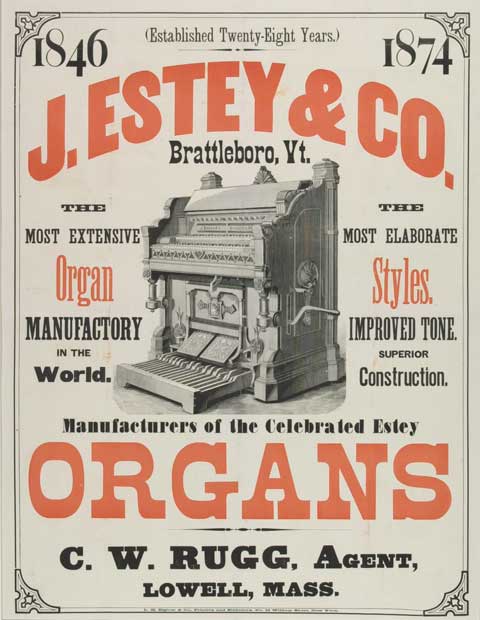
History
 |
History |
"At 17 young Estey went
to Worcester and learned of Thomas Sutton what would now be called the plumber's
trade. At that time this consisted of the making and putting in of lead pipe and
copper pumps. By the primitive methods of those days lead pipe was made by
pouring the melted lead into a mould and then drawing it out to any desired size
over a steel rod. Three years later, on Dec. 31st, 1834, when
Jacob was 20, his father died and he came up to Hinsdale to the funeral. From
thence he came over to Brattleboro and naturally sought out Stephen Parker who
had a lead pipe and pump shop here. Parker said he was tired of the business: he
would sell it for half what it was worth, and named $200 as his price. Young
Estey then had just this sum due him at Worcester, and taking a refusal of the
business for six weeks at that price, went back to Worcester to consult with his
employer. Mr. Sutton told him the chance was a good one and offered to help him
with letters of credit to Boston and New York partners. When the young man got
back to Brattleboro, however, Mr. Parker backed out of his trade, but said he
would sell his business if he could sell his house also. The price on the whole
he fixed at $1275. This looked a large sum to the young plumber, but his
judgment told him there was money in the trade, and at Parker's suggestion the
two went into Keyes & Bradley's office and had a contract for the sale drawn
up. Both parties signed it, with the forfeit fixed at $500. The deed once done,
young Jacob's soul was filled with a deadly fear lest he had assumed an
obligation which he could never fulfil, and he went to Hinsdale to consult the
friend of his boyhood, the late John Stearns, who was 12 years his senior. Uncle
John told him that he had probably got cheated, "but if you have not," he said,
"I'll help you out." On the following Monday morning, a day in February, 1835,
Mr. Stearns and Oliver Adams came over with their young friend, to investigate.
By that time Mr. Parker had sickened of his second trade and wanted to back out
of it by paying $350, whereupon Mr. Stearns bluntly told him that he would
either deed over the property or pay the full $500. The upshot of it all was
that the parties went to Stephen Greenleaf, the town clerk, who lived on what is
now the Thurber place beyond West Brattleboro, and had the papers made out, and
the money, furnished by Mr. Stearns and Mr. Adams, was paid down. Mr. Estey took
possession April 1, 1835, a few months before he was 21, and thus became a
resident of Brattleboro. The Parker house was a small cottage standing on the
site of Mr. Estey's present residence. His shop was in what was then the old
tannery building, known to this generation as the Valley mill building which
fell a victim to the flames last December..."
The Estey Organ Company was founded in 1846.
